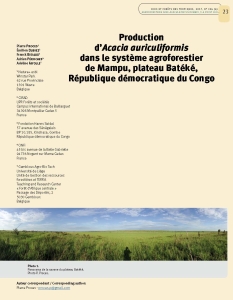Procès P., Dubiez E., Bissiaux F., Péroches A., Fayolle A.
The Mampu agroforestry zone on the Batéké plateau in the Democratic Republic of Congo, which has been managed with Acacia auriculiformis shade trees for over twenty years by local communities, supplies subsistence products and fuel wood to Kinshasa. Thanks to international grant funding, this agroforestry system, which integrates traditional slashand- burn cultivation, has been replicated in many places across the RDC, but its performance has never been assessed.
The aim of this study was to estimate Acacia auriculiformis production in terms of total biomass and usable biomass for charcoal (stems and branches more than 4 cm in diameter) as part of the agroforestry system. To do so, two local allometric equations for total and usable biomass were adjusted from destructive testing data. Using existing inventory data (n = 112 plots), we identified significant structural heterogeneity throughout the rotation period (8-10 years) but also among plots of the same age. Despite this heterogeneity, which may be accounted for by environmental conditions on site and/or by differences in the handling of plot management techniques, production is comparable to that observed at other sites, averaging 145 tonnes per hectare over 10 years. The Mampu agroforestry system has many advantages, including direct services creating rural employment and combined production of subsistence goods and charcoal, but also indirect services such as avoided deforestation and carbon sequestration. The system’s sustainability and dissemination should nevertheless be discussed.
Consultez la notice complète de l’article sur ORBi

